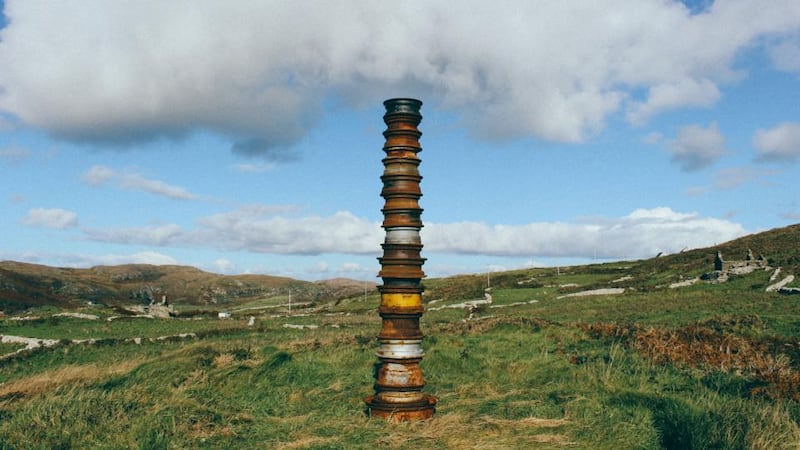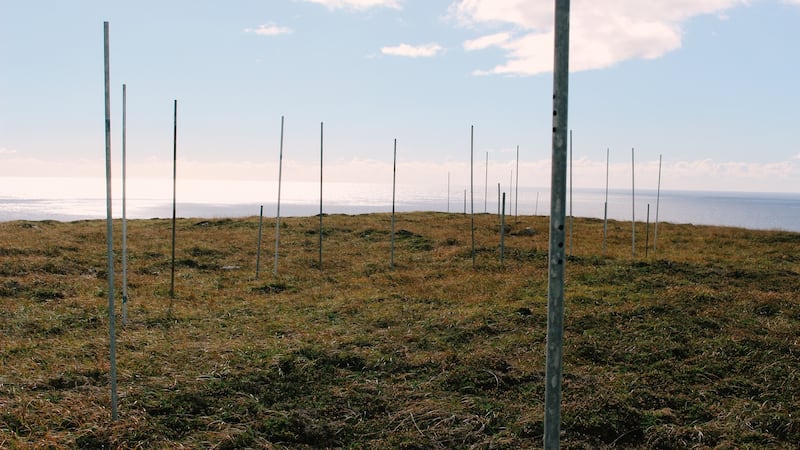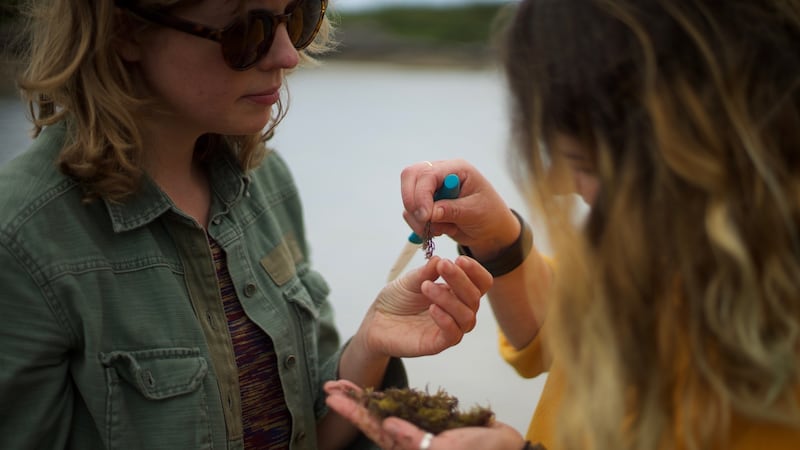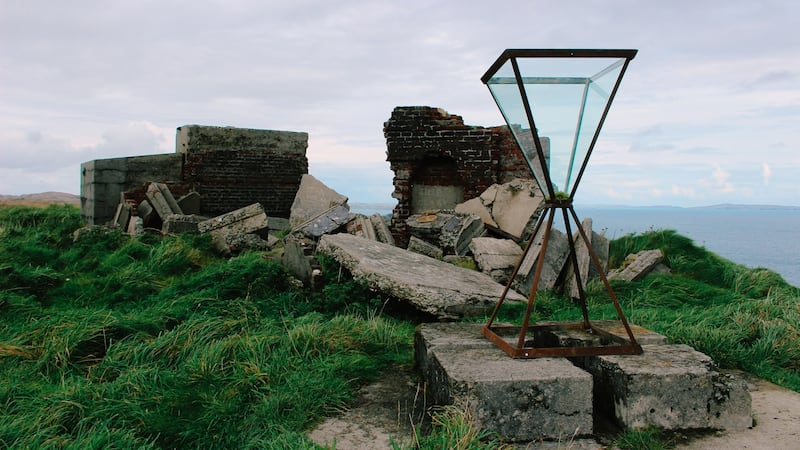When Mark Twain famously wrote of "a good walk spoiled", he was referring to golf. But what about art in the landscape? Our roadside attractions are, for the most part, disappointing. Those motorway and roundabout pieces are usually chosen by committee – it's a public space after all – so they need to be as unobjectionable as possible. Big enough to see at speed, they also need to be uninspiring enough not to cause accidents. As a result, with some honourable exceptions, they're a pretty dull lot.
Land art is a different thing. Emerging in the 1960s and 1970s as a rejection of the commercialisation of art, coupled with the growing environmental movement, land art has at its roots a political drive. Thinking about the massive projects of land art's poster boys – Robert Smithson, Walter de Maria, Michael Heizer, James Turrell – it's hard not to think of it as a gendered thing.
There's Smithson's massive Spiral Jetty (1970), a swirling earth work reaching into the Great Salt Lake in Utah. De Maria's Lightning Field (1977) consists of 400 stainless steel poles, covering an area of one mile by one kilometre in New Mexico. Then there's Turrell: his Irish Sky Garden (early 1990s) is a whacking great crater on the Liss Ard estate in West Cork. It may be awfully big, but it's still nothing to the Roden Crater, the three-mile-wide volcanic cone in Arizona that Turrell has been doing things to since 1979.
Size seems to matter even more to Heizer. When it's finished, his City, a vast complex in Nevada, will be one of the largest sculptures ever built. It's hard not to think of the big boys getting off on size, wanting to move the earth – for themselves, as well as the rest of us. Any early engagement with environmental concerns seems lost to the addictive drama of monumentalism.
Set these against the work of Nancy Holt (to whom Smithson was married): her Sun Tunnels (1976) are, quite simply, four large concrete tubes lying in the desert outside Utah. Holes bored into the concrete create a play of light into the tubes. Lie there in the shade, and dream. But then I think of Robert Janz's photographs of drawings he made in water on stone, brief snapshots of beauty soon to evaporate. Add to this Andy Goldsworthy's temporary sculptures made of snow and leaves, and Richard Long's country walks, and I realise that while the male ego may make massive art works, that's not true of all egos, nor of all men.

Land art can also be activist. In 1982, Agnes Denes planted two acres of wheat in Battery Park, New York for her Wheatfield: a Confrontation. As the artist wrote at the time "planting and harvesting a field of wheat on land worth $4.5 billion created a powerful paradox". Mary Mattingly's ongoing project Swale is a floating "food forest" sited on a barge, that docks around New York city.
This is land art that has slipped the moorings of massive earth works, creating a series of persuasive moments and inserting them unexpectedly into city life. Still, powerful as the paradox may have been, Wheatfield hasn’t exactly achieved an end to avarice in Manhattan, so what can art outside the gallery actually do?
A gentler sort
Lose the desire for permanence and scale, and land art can get so much more interesting. A project of a gentler sort, yet still with a focused agenda, is currently under way on Brow Head, on the Mizen Peninsula, west Cork. Organised by Kari Cahill and Hazel McCague, Tombolo is a month-long residency for eight artists: Emily Robyn Archer, Sophie Gough, Rosie O'Reilly, Felix Power, Theo Shields and Anna Wylie are working alongside Cahill and McCague to make temporary art projects in one of the most spectacular settings at the very edge of Europe.

Of course, it’s hard to compete with a landscape like this, so Cahill and McCague’s focus is less on huge “art moments”, and more on encouraging people to look more closely at, and think more deeply about, the world around them. “It’s the power of the experience,” agrees Cahill. “Even when you take away the art, it’s so powerful when you’re on the headland. We want to slow people down, make them think.” Why does this matter? “If you don’t know the land, don’t know the environment, how can we connect to it?” Cahill replies. “We want people to come and connect to the land, question things, and just be more considerate in their daily lives.”
Cahill and McCague's own work has taken them from art and installations at festivals, including the Electric Picnic, Body and Soul and Bloom, to painting and weaving: a recent commission has been a series of willow-weave pieces for the new Rachel Allen restaurant in Cork. Another residency project is also planned for Donegal this November.
This is the second year of Tombolo, and work from 2016 (which included artists Liliane Puthod and Margie Jean Lewis) ranged from a totem pole made from stacked tractor rims; to a woven panel of seaweed, grass and silo wrap; to a large ball of gathered bracken. Land Flutes, a cluster of steel pipes set upright in the ground, seemed, at first glance, to echo de Maria's Lightning Field, but that would be to mistake the project.

“The day we brought the artists out to the site, the fog was so thick we couldn’t see an inch in front of us,” remembers Cahill. “So we were saying: if you can just imagine the cliffs, the beach, and the view out to the Fastnet . . . It was a really windy, grubby day.” But the group could also hear an eerie sound. “It was the wind, blowing through a cattle grid, whistling with a weird melancholy sound. So we got a lot of poles. And they all sang with different tones. It was so beautiful.”
Collaboration
All the works were removed at the end of the event, and some seem to have been stronger than others. This, of course, is part of the risk of making art on site, of making art at all. “You’re always terrified,” agrees Cahill, when I ask about how they coped with works that seemed, to put it gently, “slighter” than others. “It’s a total experiment, but it always seems to work out.”
She’s keen to emphasise the collaborative nature of Tombolo. Artists were selected on the basis of a set of questions including: What was the last adventure you went on? What does community mean to you? “If one person’s work is weak,” continues Cahill, “we’re all there to help people along. We all work together to use each other’s strengths.”

This way of working is a world away from the rhetoric of art stars, excellence and carefully curated aesthetic commodification and intellectualism we’re so familiar with from the museum and gallery system. Just as a window can frame a view, art can reframe how you see the world around it, and that can also change your expectations of what art should look like. Thinking about it, you may start to lose some of the sense of “so what” at the sight of a bracken ball; and fall further in with Cahill and McCague’s world view.
So how did the public react last year? “Oh my god it was amazing,” says Cahill. “Hazel and I had worked on festivals together, and we’d got quite jaded to it. We’d come home, make a sculpture on a beach and invite people to it, to chat. The core of it is spending time, making art outdoors.
“People really got it,” she continues. “They loved that art was there on their walk along the headland. This man came down from the pub, he said he’d heard there was ‘really weird stuff going on out here’. He sat down for ages and told us his opinions – some he hated, some he loved. That’s what it’s all about.”
So if you fancy thinking more slowly about what matters in the world, get thee to Mizen, and maybe start to think differently too: about art, as well as its place, and yours, in the world.
Tombolo takes place from September 22nd to October 1st, with guided tours of the artworks each weekend. layoftheland.ie













